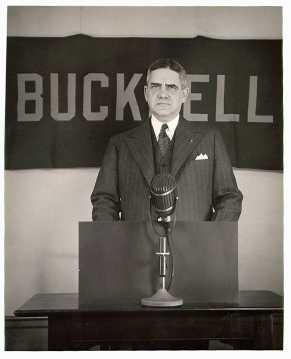| 1945 President Marts | |
 | |
Arnaud Cartwright Marts had received a Bachelor of Arts degree from Oberlin College. His first connection with Bucknell University was established when he directed the fund drive to raise money for Memorial Stadium in the 1920's. Marts was a professional fund raiser for educational and philanthropic organizations. After the completion of the stadium project, Marts directed a campaign with the goal of raising $1,000,000.00 for the university endowment, during which there was a solicitation of funds from Baptist churches in Pennsylvania, as well as from Bucknell alumni. Marts joined the Board of Trustees in 1932. After the resignation of President Homer P. Rainey in 1935, the Board of Trustees elected Marts as President, but he declined to accept. The Board then elected him Acting President, and he accepted on the condition that he remain the president of Marts and Lundy, an organization which raised funds for various philantrophies. Acting President Marts spent three days a week as President of Bucknell University and the remainder of the week in New York City with Marts and Lundy. In 1937, the Bucknell student body presented Marts with a petition requesting him to accept the title of President. At the urging of Judge J. Warren Davis and other members of the Board, Marts decided to become President, in 1938. President Marts requested that no formal inaugration be held. Marts was instrumental in raising funds to complete the pre-War building campaign and to retire the debt which had been incurred by the university. Upon his retirement in 1945, the university was free of debt. In 1936, Acting President Marts and Miss Martin, the university librarian, began the Friends of the Library, to solicit funds and books for the library. President Marts was a member of Phi Beta Kappa, and he was instrumental in the establishment of a chapter at Bucknell in 1940. The major sources for the information on this page are the Minutes of the Board of Trustees of Bucknell University, 1920-1950 (BT '20-'50). Additional sources are Theiss, Centennial History, Oliphant, Library of Bucknell University, and Oliphant, Rise of Bucknell University. |
|